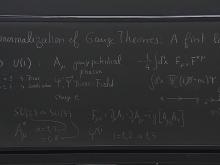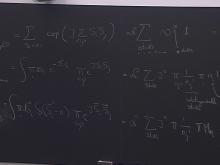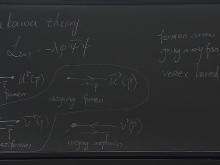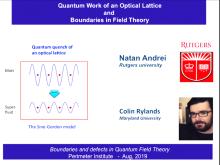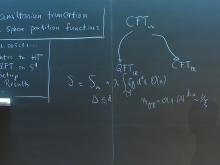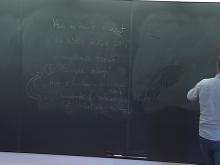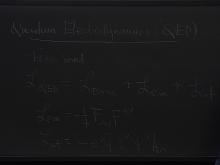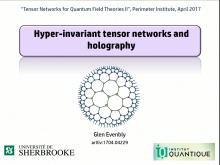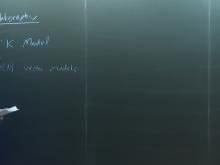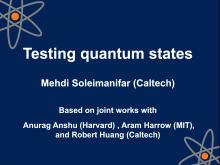Quantum field theory was originally developed as the extension of quantum mechanics needed to accommodate the principles of special relativity. Today quantum field theory is the modern paradigm with which we understand particle physics, condensed matter systems, and many aspects of early universe cosmology, and it is used to describe the interactions of elementary particles, the dynamics of many body systems and critical phenomena, all with exquisite accuracy. Currently, Perimeter researchers are producing world-leading advances in the study of integrability and scattering amplitudes in quantum field theories. String theory is a theoretical framework which was proposed to produce a unified description of all particles and forces in nature, including gravity. It is based on the idea that at very short distances, all particles should in fact be seen to be extended one-dimensional objects, i.e., ‘strings.’ Modern string theory has grown to be a broad and varied field of research with strong connections to quantum gravity, particle physics and cosmology, as well as mathematics. An exciting new framework known as ‘holography’ has emerged from string theory whereby quantum gravity is formulated in terms of quantum field theory in one less dimension. This symbiosis between quantum field theory and quantum gravity has been a focus of many Perimeter researchers. This has led to the development of exciting new methods to study the quantum dynamics of gauge theories and in the application of these techniques to new domains, such as nuclear physics and condensed matter physics
Format results
-
16 talks-Collection NumberC19042
Talk
-
PSI 2019/2020 - Statistical Mechanics (Vieira)
14 talks-Collection NumberC19041Talk
-

PSI 2019/2020 - Statistical Mechanics (Vieira)
Pedro Vieira Perimeter Institute for Theoretical Physics
PIRSA:19090119 -

PSI 2019/2020 - Statistical Mechanics (Vieira) - Lecture 2
Pedro Vieira Perimeter Institute for Theoretical Physics
-

PSI 2019/2020 - Statistical Mechanics (Vieira) - Lecture 3
Pedro Vieira Perimeter Institute for Theoretical Physics
-

PSI 2019/2020 - Statistical Mechanics (Vieira) - Lecture 4
Pedro Vieira Perimeter Institute for Theoretical Physics
-

PSI 2019/2020 - Statistical Mechanics (Vieira) - Lecture 5
Pedro Vieira Perimeter Institute for Theoretical Physics
-

PSI 2019/2020 - Statistical Mechanics (Vieira) - Lecture 6
Pedro Vieira Perimeter Institute for Theoretical Physics
-

PSI 2019/2020 - Statistical Mechanics (Vieira) - Lecture 7
Pedro Vieira Perimeter Institute for Theoretical Physics
-

PSI 2019/2020 - Statistical Mechanics (Vieira) - Lecture 8
Pedro Vieira Perimeter Institute for Theoretical Physics
-
-
PSI 2019/2020 - Quantum Field Theory (Wohns/Xu)
14 talks-Collection NumberC19040Talk
-
Boundaries and Defects in Quantum Field Theory
21 talks-Collection NumberC19035Talk
-

Symmetries and Dualities of Abelian TQFTs
Jaume Gomis Perimeter Institute for Theoretical Physics
-

TBD
Leonardo Rastelli Stony Brook University
-

Universality at large transverse spin in defect CFTs
Madalena Lemos European Organization for Nuclear Research (CERN)
-

Domain Walls in Super-QCD
Francesco Benini SISSA International School for Advanced Studies
-

Weyl Anomaly Induced Current and Holography
Rong-Xin Miao Sun Yat-sen University
-

Wilson line impurities, flows and entanglement entropy
Prem Kumar Swansea University
-

Anomalies in the Space of Coupling Constants
Nathan Seiberg Institute for Advanced Study (IAS)
-

-
-
Bootstrap 2019
11 talks-Collection NumberC19026Talk
-

CFT amplitudes
Marc Gillioz SISSA International School for Advanced Studies
-

Flux Tube S-matrix Bootstrap
Andrea Guerrieri European Organization for Nuclear Research (CERN)
-

Precision Islands for ABJM theory from Mixed Correlator Bootstrap
Shai Chester Weizmann Institute of Science Canada
-

-

Talk 13 via live stream
Carlo Meneghelli University of Oxford
-

Spinning Conformal Bootstrap in 4d
Denis Karteev L'Ecole Polytechnique Federale de Lausanne (EPFL)
-

Talk 15 via live stream
Martin Kruczenski Purdue University
-

Talk 21 via live stream
-
Walter Landry California Institute of Technology
-
David Simmons-Duffin Institute for Advanced Study (IAS)
-
-
-
PSI 2018/2019 - String Theory Review (Gaiotto)
15 talks-Collection NumberC19015Talk
-

PSI 2018/2019 - String Theory Review - Lecture 1
Davide Gaiotto Perimeter Institute for Theoretical Physics
-

PSI 2018/2019 - String Theory Review - Lecture 2
Davide Gaiotto Perimeter Institute for Theoretical Physics
-

PSI 2018/2019 - String Theory Review - Lecture 3
Davide Gaiotto Perimeter Institute for Theoretical Physics
-

PSI 2018/2019 - String Theory Review - Lecture 4
Davide Gaiotto Perimeter Institute for Theoretical Physics
-

PSI 2018/2019 - String Theory Review - Lecture 5
Davide Gaiotto Perimeter Institute for Theoretical Physics
-

PSI 2018/2019 - String Theory Review - Lecture 6
Davide Gaiotto Perimeter Institute for Theoretical Physics
-

PSI 2018/2019 - String Theory Review - Lecture 7
Davide Gaiotto Perimeter Institute for Theoretical Physics
-

PSI 2018/2019 - String Theory Review - Lecture 8
Davide Gaiotto Perimeter Institute for Theoretical Physics
-
-
Gauge Theory, Geometric Langlands and Vertex Operator Algebras
11 talks-Collection NumberC18004Talk
-

Gauge Theory, Geometric Langlands, and All That
Edward Witten Institute for Advanced Study (IAS) - School of Natural Sciences (SNS)
-

Overview of the global Langlands correspondence
Dima Arinkin University of Wisconsin-Milwaukee
-

Gauge theory, vertex algebras and quantum Geometric Langland dualities
Davide Gaiotto Perimeter Institute for Theoretical Physics
-

-

Introduction to local geometric Langlands
Sam Raskin The University of Texas at Austin
-

-

-

-
-
Quantum Black Holes in the Sky?
34 talks-Collection NumberC17055Talk
-

Quantifying the evidence for black holes with GW and EM probes
Paolo Pani Instituto Superior Tecnico - Departamento de Física
-

Echoes from the Abyss: Tentative Evidence for Planck-Scale Structure at Black Hole Horizons
Jahed Abedi University of Stavanger (UiS)
-

Improvements on the methods for searching echoes
Julian Westerweck Albert Einstein Institute
-

A model-independent search for gravitational-wave echoes
Archisman Ghosh Institucio Catalana de Recerca I Estudis Avancats (ICREA) - Universitat de Barcelona
-

An alternative significance estimation for the evidence for echoes
Alex Nielsen Albert Einstein Institute
-

Discussion: Evidence for Echoes
PIRSA:17110074 -

Inspiral Tests of Strong-field Gravity and Ringdown Tests of Quantum Black Holes
Kent Yagi University of Virginia
-

A Recipe for Echoes
Aaron Zimmerman The University of Texas at Austin
-
-
PSI 2017/2018 - Quantum Field Theory I (Wohns, Ali)
14 talks-Collection NumberC17038Talk
-

PSI 2017/2018 - Quantum Field Theory I - Lecture 1
Dan Wohns Perimeter Institute for Theoretical Physics
PIRSA:17100020 -

PSI 2017/2018 - Quantum Field Theory I - Lecture 2
Dan Wohns Perimeter Institute for Theoretical Physics
PIRSA:17100021 -

PSI 2017/2018 - Quantum Field Theory I - Lecture 3
Dan Wohns Perimeter Institute for Theoretical Physics
PIRSA:17100022 -

PSI 2017/2018 - Quantum Field Theory I - Lecture 4
Dan Wohns Perimeter Institute for Theoretical Physics
PIRSA:17100023 -

PSI 2017/2018 - Quantum Field Theory I - Lecture 5
Dan Wohns Perimeter Institute for Theoretical Physics
PIRSA:17100024 -

PSI 2017/2018 - Quantum Field Theory I - Lecture 6
Dan Wohns Perimeter Institute for Theoretical Physics
PIRSA:17100025 -

PSI 2017/2018 - Quantum Field Theory I - Lecture 7
Dan Wohns Perimeter Institute for Theoretical Physics
PIRSA:17100026 -

PSI 2017/2018 - Quantum Field Theory I - Lecture 8
Dan Wohns Perimeter Institute for Theoretical Physics
PIRSA:17100027
-
-
Tensor Networks for Quantum Field Theories II
18 talks-Collection NumberC17011Talk
-

Discretizing the many-electron Schrodinger Equation
Steven White University of California, Irvine
-

Emergence of conformal symmetry in critical spin chains
Ashley Milsted California Institute of Technology
-

-

-

Bridging Perturbative Expansions with Tensor Networks
Jutho Haegeman Ghent University
-

The continuous multi-scale entanglement renormalization ansatz (cMERA)
Guifre Vidal Alphabet (United States)
-

Unitary Networks from the Exact Renormalization of Wavefunctionals
Rob Leigh University of Illinois Urbana-Champaign
-

Tensor networks and Legendre transforms
Brian Swingle Brandeis University
-
-
It from Qubit Summer School
62 talks-Collection NumberC16003Talk
-

-

Gravity Basics - 1
Veronika Hubeny University of California, Davis
-

QI Basics - 1
Patrick Hayden Stanford University
-

Entanglement - 1
Robert Spekkens Perimeter Institute for Theoretical Physics
-

GR: Actions and Equations
David Kubiznak Charles University
-

A new perspective on holographic entanglement
Matthew Headrick Brandeis University
-

Bell’s Theorem
Adrian Kent University of Cambridge
-

QFT Basics - 1
Thomas Hartman Cornell University
-
-
Quantum Information in Quantum Gravity II
31 talks-Collection NumberC15041Talk
-

Gravity Dual of Quantum Information Metric
Tadashi Takayanagi Yukawa Institute for Theoretical Physics
-

A new perspective on holographic entanglement
Matthew Headrick Brandeis University
-

Universal holographic description of CFT entanglement entropy
Thomas Faulkner University of Illinois Urbana-Champaign
-

Geometric Constructs in AdS/CFT
Veronika Hubeny University of California, Davis
-

Do black holes create polyamory
Jonathan Oppenheim University College London
-

Tensor Network Renormalization and the MERA
Glen Evenbly Georgia Institute of Technology
-

Entanglement renormalization for quantum fields
Jutho Haegeman Ghent University
-

Holographic quantum error-correcting codes: Toy models for the bulk/boundary correspondence
Fernando Pastawski California Institute of Technology
-
-
PSI 2019/2020 - Quantum Field Theory II (David)
16 talks-Collection NumberC19042PSI 2019/2020 - Quantum Field Theory II (David) -
PSI 2019/2020 - Statistical Mechanics (Vieira)
14 talks-Collection NumberC19041PSI 2019/2020 - Statistical Mechanics (Vieira) -
PSI 2019/2020 - Quantum Field Theory (Wohns/Xu)
14 talks-Collection NumberC19040PSI 2019/2020 - Quantum Field Theory (Wohns/Xu) -
Boundaries and Defects in Quantum Field Theory
21 talks-Collection NumberC19035Boundaries and defects play central roles in quantum field theory (QFT) both as means to make contact with nature and as tools to constrain and understand QFT itself. Boundaries in QFT can be used to model impurities and also the finite extent of sample sizes while interfaces allow for different phases of matter to interact in a controllable way. More formally these structures shed light on the structure of QFT by providing new examples of dualities and renormalization group flows. Broadly speaking this meeting will focus on three areas: 1) formal and applied aspects of boundary and defect conformal field theory from anomalies and c-theorems to topological insulators 2) supersymmetry and duality from exact computations of new observables to the construction of new theories and 3) QFT in curved space and gravity from holographic computations of entanglement entropy to ideas in quantum information theory. Registration for this event is now open.
-
Bootstrap 2019
11 talks-Collection NumberC19026Quantum field theory (QFT) is a universal language for theoretical physics describing the Standard Model gravity early universe inflation and condensed matter phenomena such as phase transitions superconductors and quantum Hall fluids. A triumph of 20th century physics was to understand weakly coupled QFTs: theories whose interactions can be treated as small perturbations of otherwise freely moving particles. However weakly coupled QFTs represent a tiny island in an ocean of possibilities. They cannot capture many of the most interesting and important physical phenomena from the strong nuclear force to high temperature superconductivity.The critical challenge for the 21st century is to understand and solve strongly coupled QFTs. Meeting this challenge will require new physical insight new mathematics and new computational tools. Our collaboration combines deep knowledge of novel non-perturbative techniques with a concrete plan for attacking the problem of strong coupling. The starting point is the astonishing discovery that in numerous physical systems there is a unique quantum field theory consistent with general principles of symmetry and quantum mechanics. By analyzing the full implications of these general principles one can make sharp predictions for physical observables without resorting to approximations.This strategy is called the Bootstrap the topic of this three week program.
-
PSI 2018/2019 - String Theory Review (Gaiotto)
15 talks-Collection NumberC19015PSI 2018/2019 - String Theory Review (Gaiotto) -
Gauge Theory, Geometric Langlands and Vertex Operator Algebras
11 talks-Collection NumberC18004The workshop will explore the relation between boundary conditions in four-dimensional gauge theory the Geometric Langlands program and Vertex Operator Algebras.
-
Quantum Black Holes in the Sky?
34 talks-Collection NumberC17055The past decade has witnessed significant breakthroughs in understanding the quantum nature of black holes, with insights coming from quantum information theory, numerical relativity, and string theory. At the same time, astrophysical and gravitational wave observations can now provide an unprecedented window into the phenomenology of black hole horizons. This workshop seeks to bring together leading experts in these fields to explore new theoretical and observational opportunities and synergies that could improve our physical understanding of quantum black holes.
-
PSI 2017/2018 - Quantum Field Theory I (Wohns, Ali)
14 talks-Collection NumberC17038PSI 2017/2018 - Quantum Field Theory I (Wohns, Ali) -
Tensor Networks for Quantum Field Theories II
18 talks-Collection NumberC17011Tensor Networks for Quantum Field Theories II -
-
Quantum Information in Quantum Gravity II
31 talks-Collection NumberC15041Quantum Information in Quantum Gravity II
